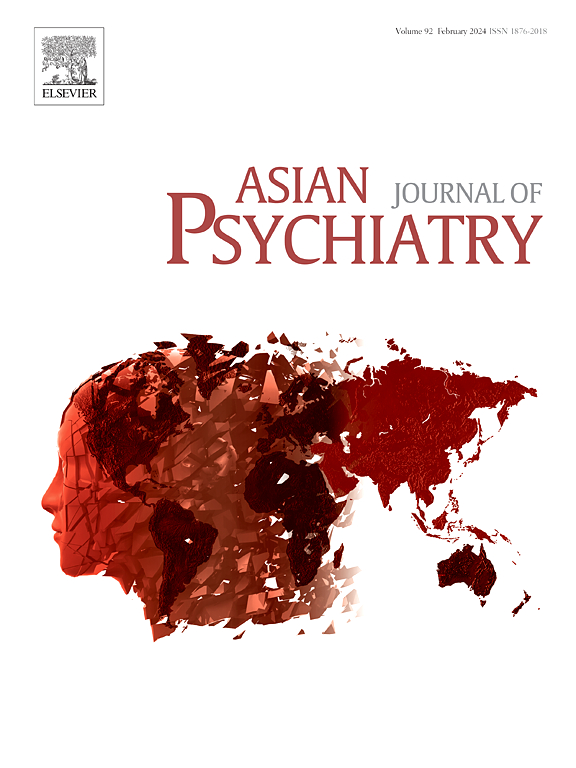The psychosis continuum: Systematic review on prodromal markers, symptom progression, and early intervention strategies
IF 4.5
4区 医学
Q1 PSYCHIATRY
引用次数: 0
Abstract
This systematic review synthesizes evidence from 60 studies (2000–2025) examining prodromal symptoms and psychotic onsets, following PRISMA guidelines. The review included 35 prospective cohort studies (58.3 %), 9 cross-sectional studies (15.0 %), 9 randomized controlled trials (15.0 %), 5 case-control studies (8.3 %), and 2 qualitative studies (3.3 %).
Prodromal presentations show marked heterogeneity, with initial manifestations predominantly non-specific (depression 52 %, worry 41 %, anxiety 38 %) before attenuated psychotic symptoms emerge. Negative symptoms typically precede positive symptoms by 12 months, with three distinct trajectories: persistent (35 %), fluctuating (42 %), and improving (23 %). Neurobiological markers demonstrate stepwise brain alterations, with machine learning approaches achieving clinically meaningful prediction accuracy (77.6 % for eye-tracking; AUC=0.84 for multimodal assessment). Environmental factors significantly influence transition risk: childhood trauma affects 61 % of UHR individuals, while cannabis use confers 4-fold increased risk (10-fold with genetic vulnerability). Notably, premorbid deterioration may reflect environmental factors (particularly high-potency cannabis) rather than elevated genetic liability.
Psychological interventions, particularly cognitive-behavioral approaches, show favorable risk-benefit profiles (NNT=5), with evidence suggesting shared anti-inflammatory mechanisms with biological treatments. Omega-3 supplementation demonstrates promise with reduced transition rates (4.9 % vs. 27.5 % controls) and favorable safety profile. Emerging interventions including low-dose lithium show potential neuroprotective effects warranting further investigation. The evidence supports expanding from transition-focused approaches to broader recovery-oriented frameworks that prioritize psychosis prevention while also addressing functioning, distress, and quality of life in all individuals at risk. We recommend personalized, stage-specific interventions integrating phenomenological, neurobiological, and intervention insights, emphasizing layered assessment, developmentally-contextualized interpretation, trauma-informed care, and accessible neurophysiological markers combined with machine learning for enhanced risk prediction.
精神病连续体:前驱标志、症状进展和早期干预策略的系统回顾。
本系统综述综合了60项研究(2000-2025)的证据,根据PRISMA指南检查了前驱症状和精神病性发作。本综述包括35项前瞻性队列研究(58.3% %)、9项横断面研究(15.0% %)、9项随机对照试验(15.0% %)、5项病例对照研究(8.3 %)和2项定性研究(3.3 %)。前驱症状的表现具有明显的异质性,在出现减轻的精神病症状之前,初始表现主要是非特异性的(抑郁52% %,担忧41% %,焦虑38% %)。阴性症状通常先于阳性症状12个月,有三种不同的轨迹:持续(35% %)、波动(42% %)和改善(23% %)。神经生物学标记显示大脑逐步改变,机器学习方法实现了有临床意义的预测精度(眼动追踪77.6% %;多模态评估AUC=0.84)。环境因素显著影响过渡风险:童年创伤影响61% %的UHR个体,而使用大麻使风险增加4倍(遗传易感性增加10倍)。值得注意的是,病前恶化可能反映了环境因素(特别是高效大麻),而不是遗传易感性升高。心理干预,特别是认知行为方法,显示出良好的风险-收益曲线(NNT=5),有证据表明与生物治疗有共同的抗炎机制。Omega-3补充剂具有降低过渡率(4.9 % vs. 27.5% %对照)和良好的安全性。包括低剂量锂在内的新兴干预措施显示出潜在的神经保护作用,值得进一步研究。证据支持从以过渡为重点的方法扩展到更广泛的以康复为导向的框架,优先考虑精神病预防,同时也解决所有风险个体的功能、痛苦和生活质量。我们推荐个性化的、针对特定阶段的干预措施,整合现象学、神经生物学和干预的见解,强调分层评估、发育情境化解释、创伤知情护理和可获取的神经生理学标志物,并结合机器学习来增强风险预测。
本文章由计算机程序翻译,如有差异,请以英文原文为准。
求助全文
约1分钟内获得全文
求助全文
来源期刊

Asian journal of psychiatry
Medicine-Psychiatry and Mental Health
CiteScore
12.70
自引率
5.30%
发文量
297
审稿时长
35 days
期刊介绍:
The Asian Journal of Psychiatry serves as a comprehensive resource for psychiatrists, mental health clinicians, neurologists, physicians, mental health students, and policymakers. Its goal is to facilitate the exchange of research findings and clinical practices between Asia and the global community. The journal focuses on psychiatric research relevant to Asia, covering preclinical, clinical, service system, and policy development topics. It also highlights the socio-cultural diversity of the region in relation to mental health.
 求助内容:
求助内容: 应助结果提醒方式:
应助结果提醒方式:


